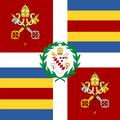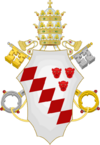User:Latium/Sandbox9: Difference between revisions
No edit summary |
No edit summary |
||
| Line 111: | Line 111: | ||
'''Fabria''', officially '''Sacred Fabria''' ([[Standard Latin language|Latin]]: ''Fabria Sacra''), is a [[Pope (Ajax)|Papal]] [[wikipedia:fief|fief]] and special administrative located entirely within [[Castellum ab Alba]]. Unlike the independent [[Pontifical States]] that preceded it, Fabria is a special administrative area subject to [[Latium]] and its laws, located entirely within the city of [[Castellum ab Alba]]. Fabria is governed through the [[Treaty on Liberties and Privileges|1679 Treaty on Liberties and Privileges]], which, along with restoring the Papacy to its original seat in Fabria, Castellum, established the relationship between the [[Monarchy of Latium|Emperor]] and the [[Pope (Ajax)|Pope]]. | '''Fabria''', officially '''Sacred Fabria''' ([[Standard Latin language|Latin]]: ''Fabria Sacra''), is a [[Pope (Ajax)|Papal]] [[wikipedia:fief|fief]] and special administrative located entirely within [[Castellum ab Alba]]. Unlike the independent [[Pontifical States]] that preceded it, Fabria is a special administrative area subject to [[Latium]] and its laws, located entirely within the city of [[Castellum ab Alba]]. Fabria is governed through the [[Treaty on Liberties and Privileges|1679 Treaty on Liberties and Privileges]], which, along with restoring the Papacy to its original seat in Fabria, Castellum, established the relationship between the [[Monarchy of Latium|Emperor]] and the [[Pope (Ajax)|Pope]]. | ||
Fabria dates back to early [[Sarpetic religions|Sarpetism]] and [[wikipedia:early Christianity|early Christianity]] as the primary episcopal see of the Catholic Church under the support of the ancient Latin emperors, who served as the [[Bishop of Alba]]. The Papacy fled Castellum during the [[Ostian War]] and the [[Crisis of the Eleventh Century]], later establishing its seat in | Fabria dates back to early [[Sarpetic religions|Sarpetism]] and [[wikipedia:early Christianity|early Christianity]] as the primary episcopal see of the Catholic Church under the support of the ancient Latin emperors, who served as the [[Bishop of Alba]]. The Papacy fled Castellum during the [[Ostian War]] and the [[Crisis of the Eleventh Century]], later establishing its seat in Sicaea, located in parts of modern day [[Lihnidos]]. The modern tenancy of the papacy in Castellum began during the [[Wars of Religion (Ajax)|Wars of Religion]] and the eventual Sack of Sicaea, which resulted in the near destruction of papal authority. The [[Treaty on Liberties and Privileges|1679 Treaty on Liberties and Privileges]] resulted in the restoration of the Papacy to its original seat in Castellum, in the Fabria district. | ||
Its government structure is governed by the 1679 Treaty that established it as an [[wikipedia:Ecclesiastical fief|ecclesiastical fief]] held by the Pope to provide him with a seat for Papal Court, administrative, diplomatic, spiritual and offices, as well as use of Archbasilica of Saint Peter and other facilities within the territory. However, the territory of Fabria does not confer any sovereignty, which is instead placed upon the office of Papacy by longstanding [[wikipedia:international law]]. As a result, various national governments hold embassies with the Pope, some of which are located within Fabria. | Its government structure is governed by the 1679 Treaty that established it as an [[wikipedia:Ecclesiastical fief|ecclesiastical fief]] held by the Pope to provide him with a seat for Papal Court, administrative, diplomatic, spiritual and offices, as well as use of Archbasilica of Saint Peter and other facilities within the territory. However, the territory of Fabria does not confer any sovereignty, which is instead placed upon the office of Papacy by longstanding [[wikipedia:international law]]. As a result, various national governments hold embassies with the Pope, some of which are located within Fabria. | ||
Revision as of 03:47, 23 November 2021
Sacred Fabia Fabria Sacra | |
|---|---|
| Location of the Sacred Fabria within Castellum Location of the Sacred Fabria within Castellum | |
| Country | |
| Fief granted | 19 April 1679 |
| Official languages | Latin |
| Religion | Fabrian Catholicism |
| Government | Ecclesiastical elective fief within a semi-constitutional monarchy |
• Emperor | Constantine XX Claudius |
• Pope | Pontian XI |
• Prefect | Constantinus Apronianus |
| Theodorus Afinius | |
| Legislature | Pontfical College |
| Population | |
• 2021 estimate | 500 |
| Currency | Solidus ($) |
| Time zone | +4 (IT) |
| Date format | dd/mm/yyyy (AD) |
| Driving side | left |
| Calling code | +4 099 |
| ISO 3166 code | IL FS |
| Police | Alba Pontificalis Vigiles |
| Patron saint | Saint Peter |
Fabria, officially Sacred Fabria (Latin: Fabria Sacra), is a Papal fief and special administrative located entirely within Castellum ab Alba. Unlike the independent Pontifical States that preceded it, Fabria is a special administrative area subject to Latium and its laws, located entirely within the city of Castellum ab Alba. Fabria is governed through the 1679 Treaty on Liberties and Privileges, which, along with restoring the Papacy to its original seat in Fabria, Castellum, established the relationship between the Emperor and the Pope.
Fabria dates back to early Sarpetism and early Christianity as the primary episcopal see of the Catholic Church under the support of the ancient Latin emperors, who served as the Bishop of Alba. The Papacy fled Castellum during the Ostian War and the Crisis of the Eleventh Century, later establishing its seat in Sicaea, located in parts of modern day Lihnidos. The modern tenancy of the papacy in Castellum began during the Wars of Religion and the eventual Sack of Sicaea, which resulted in the near destruction of papal authority. The 1679 Treaty on Liberties and Privileges resulted in the restoration of the Papacy to its original seat in Castellum, in the Fabria district.
Its government structure is governed by the 1679 Treaty that established it as an ecclesiastical fief held by the Pope to provide him with a seat for Papal Court, administrative, diplomatic, spiritual and offices, as well as use of Archbasilica of Saint Peter and other facilities within the territory. However, the territory of Fabria does not confer any sovereignty, which is instead placed upon the office of Papacy by longstanding wikipedia:international law. As a result, various national governments hold embassies with the Pope, some of which are located within Fabria.
Today, Fabria is home to approximately 500 residents. It is home to a number of cultural and religious sites, such as the Archbasilica of St. Peter, Fabrian Museums, Fabrian Archives, and the Great Chapel. The local economy is primarily supported through financial donations, the sale of souvenirs, admission fees at museums or galleries, and financial support from the Latin emperors.

